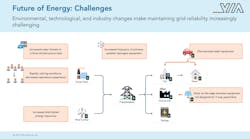Global Data Asset Collaborative to Increase ROI for Utilities
Maintaining uptime on transmission and distribution (T&D) equipment has always been challenging, but the changing energy landscape is making utility managers’ jobs even more difficult every day. Challenges vary from global trends such as the increased frequency and intensity of severe weather to industry specific factors such as growing two-way power flow from cheaper solar. All of these are part of the larger trend of an increasingly interconnected, distributed network. Many utilities recognize that the challenge of maintaining grid reliability is now greater than any single company is able to solve on its own.
When other industries (financial services, retail, healthcare) faced similar, industry-wide changes, they turned to data analytics as a solution. The power industry, however, struggles with its data. For example, utility companies’ IT and data policies often make getting access to data or transferring data near impossible. Even when the data is made available, there are always missing values or incorrect readings, resulting in utilities spending a vast majority of time on cleaning the data rather than the actual analysis. And, while every utility says they are "swimming" in data, no single company sees the full range of subtle anomalies that can occur.
To solve for these issues, leading energy analytics company, VIA launched an initiative where utilities collaborate together. Using VIA’s artificial intelligence (AI) algorithms, trained using data across utility members, the collaborative sees the widest range of anomalies and issues. The uniqueness of VIA’s approach is its underlying technology that allows each utility’s data to stay on premise at each member’s facility. Managers at utilities are reassured that their data is kept private and isn’t aggregated or centralized with other companies. VIA is calling this the "Global Data Asset Collaborative" or GDAC.
Both utilities and regulators benefit from GDAC. For utilities, what VIA has found is that by protecting the data of each company, the data issues become easier and the focus of analytics efforts returns to the analysis (not restrictions to sharing the data). The impact on members who take this collaborative approach is that they end up with greatly improved analytics. For example, members get benchmarks of their equipment condition and maintenance routines in a more real-time and customized manner. They also get the benefit of learning from issues that others have had rather than just issues that they have seen — this leads to earlier warnings about equipment. And finally, as an economic impact, GDAC members have been seeing fewer corrective maintenance callouts, better planning for spares and inventory, and faster and simpler preparation for rate cases.
For regulators, they find it easier to understand and agree to add new assets or a change in operations and maintenance (O&M) practices if they can see that other utilities have already taken similar actions. Regulators also appreciate an audit trail of analysis that provides complete transparency into which parties have access to grid data and for what purpose.
VIA initially worked with Iberdrola in Spain to gain experience in transformer equipment. Soon after, Vector from New Zealand and Hawaiian Electric in the United States became founding GDAC members focused on transformer condition-based maintenance. Most companies have been analyzing transformers for years so it’s easy to assess the improvement that GDAC is having. Although only launched earlier in 2019, the ROI for GDAC members has been in the 4x range.
As Kate Ravanis, chief operating officer (COO) of VIA explains, "The key technological innovation is the ability to do the analysis while keeping each company’s data private and separate." Ravanis illustrates how the system works, "Whether you want a simple benchmark comparison or an advanced AI-predictive model, an analyst needs to query the data. What VIA’s system does is it lets analysts write their questions as "scripts" and sends those scripts to the data. The scripts are first validated (Are you who say you are? Is data available?) and only if valid, they are sent to the relevant members. Each member can even store their data in a different format and in different kinds of databases." VIA’s software takes care of translating the questions across formats and databases for them. The scripts run locally and only the answer is sent back to the analyst. None of the underlying data is revealed in the process.
In addition to the privacy preserving analytics foundation, there’s a lot behind GDAC to make it work and scale:
- First, there are a number of AI and other software components to help identify data issues and clean them up.
- Second, permissions are captured in blockchain-based smart contracts (that is, software-coded binding agreements) that are preapproved and agreed upon between data owners (utilities) and analysts, and referred to during the analysis to ensure the enforcement of all constraints.
- Third, there’s a set of AI models to predict the condition of transformers in the future that, critically for O&M managers, includes explanations of why the condition is expected to change.
As Vector, Hawaiian Electric, and other utilities point out, the key to success for grid reliability through GDAC is more members. VIA is vetting new members interested in joining the collaborative.




